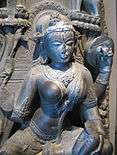Avatar
An avatar (Sanskrit: अवतार, IAST: avatāra) is a concept in Hinduism and it means "descent", and refers to the appearance or incarnation of a deity on earth.[1][2] The term also generally refers to "alight, to make one's appearance" and sometimes used to refer to any revered guru or human being.[3][4]
The word avatar does not appear in the Vedic literature,[5] but appears in verb forms in post-Vedic literature, and as a noun particularly in the Puranic literature after the 6th century CE.[6] The Rigveda describes Indra as endowed with a mysterious power of assuming any form at will.[7][8] The Bhagavad Gita expounds the doctrine of Avatara but with terms other than avatar.[6][9]
Theologically, the term is most often associated with the Hindu god Vishnu, though the idea has been applied to other deities.[10] Varying lists of avatars of Vishnu appear in Hindu scriptures, including the ten Dashavatara of the Garuda Purana and the twenty-two avatars in the Bhagavata Purana, though the latter adds that the incarnations of Vishnu are innumerable.[11] The avatars of Vishnu are important in Vaishnavism theology. In the goddess-based Shaktism tradition of Hinduism, avatars of the Devi in different appearances such as Tripura Sundari, Durga and Kali are commonly found.[12][13][14] While avatars of other deities such as Ganesha and Shiva are also mentioned in medieval Hindu texts, this is minor and occasional.[15] The incarnation doctrine is one of the important differences between Vaishnavism and Shaivism traditions of Hinduism.[16][17]
Incarnation concepts similar to avatar are also found in Buddhism,[18] Christianity[5] and others.[18] The scriptures of Sikhism include the names of numerous Hindu gods and goddesses, but it rejected the doctrine of savior incarnation and endorsed the view of Hindu Bhakti movement saints such as Namdev that formless eternal god is within the human heart and man is his own savior.[19][20]
Etymology and meaning
The Sanskrit noun (avatāra /ˈævəˌtɑːr, ˌævəˈtɑːr/;[21] Hindustani: [əʋˈt̪aːr]) is derived from the Sanskrit roots ava (down) and tṛī (to cross over).[22] These roots trace back, states Monier-Williams, to -taritum, -tarati, -rītum.[3]
Avatar literally means "descent, alight, to make one's appearance",[3] and refers to the embodiment of the essence of a superhuman being or a deity in another form.[22] The word also implies "to overcome, to remove, to bring down, to cross something".[3] In Hindu traditions, the "crossing or coming down" is symbolism, states Daniel Bassuk, of the divine descent from "eternity into the temporal realm, from unconditioned to the conditioned, from infinitude to finitude".[5] An avatar, states Justin Edwards Abbott, is a saguna (with form, attributes) embodiment of the nirguna Brahman or Atman (soul).[23]
Neither the Vedas nor the Principal Upanishads ever mention the word avatar as a noun.[5] The verb roots and form, such as avatarana, do appear in ancient post-Vedic Hindu texts, but as "action of descending", but not as an incarnated person (avatara).[24] The related verb avatarana is, states Paul Hacker, used with double meaning, one as action of the divine descending, another as "laying down the burden of man" suffering from the forces of evil.[24]
The term is most commonly found in the context of the Hindu god Vishnu.[1][3] The earliest mention of Vishnu manifested in a human form to empower the good and fight against evil, uses other terms such as the word sambhavāmi in verse 4.6 and the word tanu in verse 9.11 of the Bhagavad Gita,[4] as well as other words such as akriti and rupa elsewhere.[25] It is in medieval era texts, those composed after the sixth century CE, that the noun version of avatar appears, where it means embodiment of a deity.[26] The idea proliferates thereafter, in the Puranic stories for many deities, and with ideas such as ansha-avatar or partial embodiments.[4][1]
The term avatar, in colloquial use, is also an epithet or a word of reverence for any extraordinary human being who is revered for his or her ideas.[22] In some contexts, the term avatara just means a "landing place, site of sacred pilgrimage", or just "achieve one's goals after effort", or retranslation of a text in another language.[3] The term avatar is not unique to Hinduism. It is found in the Trikaya doctrine of Mahayana Buddhism, in descriptions for the Dalai Lama in Tibetan Buddhism, and many ancient cultures.[18]
Avatar versus incarnation
The manifest embodiment is sometimes referred to as an incarnation.[27] The translation of avatar as "incarnation" has been questioned by Christian theologists, who state that an incarnation is in flesh and imperfect, while avatar is mythical and perfect.[28][29] The theological concept of Christ as an incarnation, as found in Christology, presents the Christian concept of incarnation. According to Oduyoye and Vroom, this is different from the Hindu concept of avatar because avatars in Hinduism are unreal and is similar to Docetism.[30] Sheth disagrees and states that this claim is an incorrect understanding of the Hindu concept of avatar.[31][note 1] Avatars are true embodiments of spiritual perfection, one driven by noble goals, in Hindu traditions such as Vaishnavism.[31]
Avatars of Vishnu
The concept of avatar within Hinduism is most often associated with Vishnu, the preserver or sustainer aspect of God within the Hindu Trinity or Trimurti of Brahma, Vishnu and Shiva. Vishnu's avatars descend to empower the good and fight evil, thereby restoring Dharma. An oft-quoted passage from the Bhagavad Gita describes the typical role of an avatar of Vishnu:[10][29]
Whenever righteousness wanes and unrighteousness increases I send myself forth.
For the protection of the good and for the destruction of evil,
and for the establishment of righteousness,
I come into being age after age.— Bhagavad Gita 4.7–8
The Vishnu avatars appear in Hindu mythology whenever the cosmos is in crisis, typically because the evil has grown stronger and has thrown the cosmos out of its balance.[33] The avatar then appears in a material form, to destroy evil and its sources, and restore the cosmic balance between the everpresent forces of good and evil.[33]
The most known and celebrated avatars of Vishnu, within the Vaishnavism traditions of Hinduism, are Krishna, Rama, Narayana and Vasudeva. These names have extensive literature associated with them, each has its own characteristics, legends and associated arts.[29] The Mahabharata, for example, includes Krishna, while the Ramayana includes Rama.[34]
Dashavatara
The Bhagavata Purana describes Vishnu's avatars as innumerable, though ten of his incarnations (Dashavatara), are celebrated therein as his major appearances.[11][29] The ten major Vishnu avatars are mentioned in the Agni Purana, the Garuda Purana and the Bhagavata Purana;[35][36][note 2] thirty-nine avatars are mentioned in the Pañcaratra.[38] The commonly accepted number of ten avatars for Vishnu was fixed well before the 10th century CE.[35]
The ten best known avatars of Vishnu are collectively known as the Dasavatara (a Sanskrit compound meaning "ten avatars"). Five different lists are included in the Bhagavata Purana, where the difference is in the sequence of the names. Freda Matchett states that this re-sequencing by the composers may be intentional, so as to avoid implying priority or placing something definitive and limitation to the abstract.[39]
| Name | Description | Image | Reference |
|---|---|---|---|
| Matsya | Half fish-half man avatar. He saves the world from a cosmic flood, with the help of a boat made of the Vedas (knowledge), on which he also rescues Manu (progenitor of man) and all living beings. A demon steals and tries to destroy the Vedas, but Matsya finds the demon, kills him, and returns the Vedas. | |
[40] |
| Kurma[note 3] | Tortoise avatar. He supports the cosmos, while the gods and demons churn the cosmic ocean with the help of serpent Vasuki to produce the nectar of immortality (just like churning milk to produce butter). The churning produces both the good and the bad, including poison and immortality nectar. Nobody wants the poison, everyone wants the immortality nectar. The demons attempt to steal the nectar, wherein Vishnu appears as enchantress Mohini avatar, for whom they all fall, and give her the nectar. | |
[41] |
| Varaha | Boar avatar. He rescues goddess earth when the demon Hiranyaksha kidnaps her and hides her into the depths of cosmic ocean. The boar finds her and kills the demon, and the goddess holds onto the tusk of the boar as he lifts her back to the surface. | 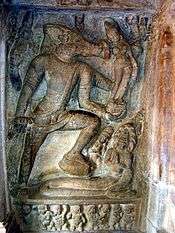 |
[42] |
| Narasimha | Half lion-half man avatar. Demon king Hiranyakashipu becomes enormously powerful, gains special powers by which no man or animal could kill him, then bullies and persecutes people who disagree with him, including his own son. The Man-Lion avatar creatively defeats those special powers, kills Hiranyakashipu, and rescues demon's son Prahlada who opposes his own father. The legend is a part of the Hindu festival Holi folklore. | 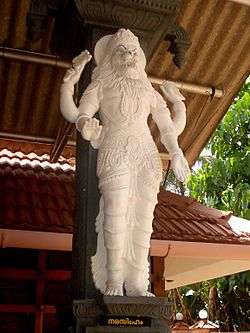 |
[43] |
| Vamana | Dwarf avatar. Demon king Bali gains disproportionately enormous powers, ruling the entire universe and abusing it. The dwarf avatar approaches Bali in the form of a monk, when Bali is trying to show off by giving alms at a sacrifice. Bali offers the dwarf any riches he wants, the monk refuses and asks for three steps of land. Bali grants it to him. The dwarf grows, in his first step takes the earth, the second all of the heavens, and for the third the netherworld where Bali returns to. | 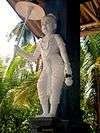 |
[44] |
| Parashurama | Sage with an axe avatar. The warrior class gets too powerful, and seizes other people's property for their own pleasure. The avatar appears as a sage with an axe, kills the king and all his warrior companions. |  |
[45] |
| Rama | Subject of Ramayana | 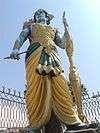 |
[46] |
| Krishna | Subject of the Mahabharata and the Bhagavad Gita | 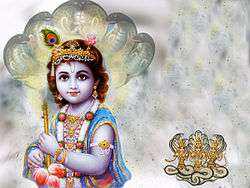 |
[47] |
| Buddha | Subject of Buddhism.[48] Some Hindu texts replace Buddha with Balarama or with Rishabhanatha, the first Tīrthankara of Jainism.[49] |  |
[50][note 4] |
| Kalki[note 5] | The last avatar appears as man with a white horse with wings, projected to end the Kali yuga, in order that the cosmos may renew and restart. | 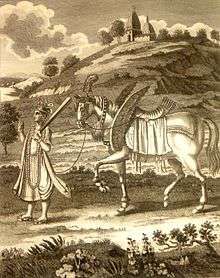 |
[44] |
Types
The avatar concept was further developed and refined in later Hindu texts. One approach was to identify full avatar and partial avatars; Krishna, Rama and Narasimha were full avatars (purna avatars), while others were partial avatars (ansha avatars).[32] Some declared, states Noel Sheth, that every living creature is an avatar of Vishnu.[32] The Pancharatra text of Vaishnavism declares that Vishnu's avatar include those that are direct and complete (sakshad), indirect and endowed (avesha), cosmic and salvific (vyuha), inner and inspirational (antaryamin), consecrated and in the form of image (archa).[32]
Yet another classification, developed in Krishna schools, centers around Guna-avatars, Purusha-avatars and Lila-avatars, with their subtypes.[52][53] The Guna-avatar classification of avatars is based on the Guṇas concept of the Samkhya school of Hindu philosophy, that is Rajas (Brahma), Sattva (Vishnu), and Tamas (Shiva).[52][53] These personalities of the Trimurti is referred to as Guna avatars.[52] The Purushavatara are three. The first evolves the matter (Prakriti), the second is the soul present in each individual creature, the third is the interconnected oneness or Brahman that connects all souls.[52][54] The Lilavataras are partial or full manifestations of Vishnu, where either some powers (Shakti) or material parts of him exist.[52][53]
Vishnu is Purushavatara.[55][56] The Matsya, Kurma and Vamana avatars of Vishnu are Lilavataras.[53][55] A Purnarupa in this classification, is when Vishnu manifests completely along with his qualities and powers. In Bengal Vaishnavism, Krishna is the Purnarupa.[52] In Shaivism, Bhairava is the purnarupa of Shiva.[57]
In Sikhism
24 avatars of Vishnu are mentioned in Bachitar Natak's composition in Dasam Granth, the second scripture of Sikhs written by Guru Gobind Singh:[58]
- Macha (Matsya)
- Kaccha (Kurma)
- Narayana (Narayana in Nara-Narayana)
- Maha Mohini (Mohini)
- Bairaha (Varaha)
- Nar Singha (Narasimha)
- Bavana (Vamana)
- Parashurama
- Brahma
- Rudra (Shiva)
- Jalandhara
- Bishan (Vishnu)
- Sheshayi (Shesh)
- Arihant Dev
- Manu Raja
- Dhanvantari
- Suraja (the sun)
- Chandara (the moon)
- Rama
- Balarama
- Krishna
- Nara (Nara in Nara-Narayana, ie, Arjuna)
- Buddha
- Kalki
The Guru Granth Sahib reverentially includes the names of numerous Hindu deities, including Vishnu avatars such Krishna, Hari and Rama, as well those of Devi as Durga.[59][60][61]
Dasam Granth has three major compositions, one each dedicated to avatars of Vishnu (Chaubis avatar), Rudra and Brahma.[58][62] However, Sikhism rejects the doctrine of savior incarnation, and only accepts the abstract nirguna formless god.[19][63] The Sikh Gurus endorsed the view of Hindu Bhakti movement saints such as Namdev (~1270 – 1350 CE) that formless eternal god is within human heart and man is his own savior.[19][64]
Avatars of Ganesha
The Linga Purana declares that Ganesha incarnates to destroy demons and to help the gods and pious people.[65] The two upapuranas – Ganesha Purana and Mudgala Purana – detail the avatars of Ganesha. Both these upapuranas are core scriptures of the Ganapatya sect – exclusively dedicated to Ganesha worship.
Four avatars of Ganesha are listed in the Ganesha Purana: Mohotkata, Mayūreśvara, Gajanana and Dhumraketu. Each avatar corresponds to a different yuga, has a different mount and different skin complexion, but all the avatars have a common purpose – to slay demons.[66]
The Mudgala Purana describes eight avatars of Ganesha:[67]
- Vakratunda (Vakratuṇḍa) ("twisting trunk"), his mount is a lion.
- Ekadanta ("single tusk"), his mount is a mouse.
- Mahodara ("big belly"), his mount is a mouse.
- Gajavaktra (or Gajānana) ("elephant face"), his mount is a mouse.
- Lambodara ("pendulous belly"), his mount is a mouse.
- Vikata (Vikaṭa) ("unusual form", "misshapen"), his mount is a peacock.
- Vighnaraja (Vighnarāja) ("king of obstacles"), his mount is the celestial serpent Śeṣa.
- Dhumravarna (Dhūmravarṇa) ("grey color") corresponds to Śiva, his mount is a horse.
Avatars of Shiva
Although Puranic scriptures contain occasional references to avatars of Shiva, the avatar doctrine is neither universally accepted nor commonly adopted in Shaivism.[68] The views on the doctrine of incarnation has been one of the significant doctrinal differences between Vaishnavism and Shaivism, in addition to their differences on the role of householder life versus monastic life for spiritual release.[16][17][69] Shaivism is a transcendental theology, where man, with the help of his Guru, is his own savior.[69]
The Linga Purana lists twenty-eight avatars of Shiva.[70] In the Shiva Purana there is a distinctly Saivite version of a traditional avatar myth: Shiva brings forth Virabhadra, one of his terrifying forms, in order to calm Narasimha, an avatar of Vishnu. When that fails, Shiva manifests as the human-lion-bird Sharabha which calms down lion-bird Narasimha avatar of Vishnu, and Shiva then gives Vishnu a chakra as gift. A similar story is told in the late medieval era Sharabha Upanishad.[71] However, Vaishnava Dvaita school refutes this Shaivite view of Narasimha.[72]
The monkey-god Hanuman who helped Rama – the Vishnu avatar is considered by some to be the eleventh avatar of Rudra (Shiva).[73][74] Some regional deities like Khandoba are also believed by some to be avatars of Shiva.[75][76]
In Dasam Granth, Guru Gobind Singh mentioned two avatars of Rudra: Dattatreya Avatar and Parasnath Avatar.[77]
Avatars of Devi
Avatars are also observed in Shaktism, the sect dedicated to the worship of the Goddess (Devi), but they do not have universal acceptance in the sect. The Devi Bhagavata Purana describes the descent of Devi avatars to punish the wicked and defend the righteous—much as the Bhagavata Purana does with the avatars of Vishnu.[78] Like Vishnu, his consort Lakshmi incarnates as Sita and Radha – the consorts of Rama and Krishna avatars.[79] Nilakantha, an 18th-century commentator on the Devi Bhagavata Purana – which includes the Devi Gita – says that various avatars of the Goddess includes Shakambhari and even the masculine Krishna and Rama – generally thought to be Vishnu's avatars.[80] Lakshmi and Saraswati are also goddesses worshipped as Devi avatars.[81]
Avatars of Lakshmi
Sridevi and Bhudevi are two different forms of Goddess Lakshmi. Dharini, the consort of Parashurama, Sita, the consort of Rama and Yashodhara, the consort of Buddha along with the consorts of the previous incarnations of Vishnu are all considered full incarnations of Lakshmi. On the other hand, Radha and the gopis, Rukmini, Satyabhama and the rest of Krishna's wives with the exception of Yamuna are all considered partial incarnations of Lakshmi.
Avatars of Brahma
In Dasam Granth, second scriptures of Sikhs written by Guru Gobind Singh, mentioned seven Brahma Avatars.[82]
- Valmiki Avatar
- Kashyapa Avatar
- Sukra Avatar
- Bachesa Avatar
- Vyasa Avatar
- Khata Rishi Avatar
- Kalidasa Avatar
See also
- Avatars in the Mahabharata
- Dashavatara
- Gautama Buddha in Hinduism
- Incarnation
- List of avatar claimants
Notes
- ↑ Buddha, a real person, is included as an avatar of Vishnu in many Hindu texts.[32]
- ↑ Alternate lists of Vishnu avatars are found in medieval Hindu texts. For example, twenty-two avatars of Vishnu are listed numerically in chapter 1.3 of the Bhagavata Purana [BP]:[37] Four Kumaras (Catursana) [BP 1.3.6] – the four Sons of god Brahma and exemplified the path of devotion, Varaha [BP 1.3.7], Narada [BP 1.3.8] the divine-sage who travels the worlds as a devotee of Vishnu, Nara-Narayana [BP 1.3.9] – the twin-sages, Kapila [BP 1.3.10] – a renowned sage spoken of in the Mahabharata, son of Kardama Muni and Devahuti and sometimes identified with the founder of the Samkhya school of philosophy, Dattatreya [BP 1.3.11] – the combined avatar of the Hindu trinity Brahma, Vishnu and Shiva. He was born to the sage Atri became a great seer himself; Yajna [BP 1.3.12] – the lord of fire-sacrifice, who took was the Indra – the lord of heaven, Rishabha [BP 1.3.13] – the father of King Bharata and Bahubali, Prithu [BP 1.3.14] – the sovereign-king who milked the earth as a cow to get the world's grain and vegetation and also invented agriculture, Matsya [BP 1.3.15], Kurma [BP 1.3.16], Dhanvantari [BP 1.3.17] – the father of Ayurveda medicine and a physician to the Devas, Mohini [BP 1.3.17] – the enchantress, Narasimha [BP 1.3.18], Vamana [BP 1.3.19], Parashurama [BP 1.3.20], Vyasa [BP] 1.3.21] – the compiler of the scriptures – Vedas and writer of the scriptures Puranas and the epic Mahabharata, Rama [BP 1.3.22], Krishna [BP 1.3.23], Balarama [BP 1.3.23], Buddha [BP 1.3.24], Kalki [BP 1.3.25]
- ↑ Mohini, the female avatar of Vishnu, appears in stories about the Kurma avatar.[41]
- ↑ Some versions include Balarama (the elder brother of Krishna) as the eighth avatar, with Krishna listed as the ninth instead of Buddha, while others replace Buddha with Balarama as the ninth avatar.Jayadeva in his Git Govinda instead adds both Balarama and Buddha,but omits Krishna as he is taken as the equivalent of Vishnu,the origin of all avatars.[51]
- ↑ Some medieval Indian texts spell it as Kalkin.
References
- 1 2 3 James Lochtefeld (2002), "Avatar" in The Illustrated Encyclopedia of Hinduism, Vol. 1: A-M, Rosen Publishing, ISBN 0-8239-2287-1, pages 72-73
- ↑ Geoffrey Parrinder (1997). Avatar and Incarnation: The Divine in Human Form in the World's Religions. Oneworld. pp. 19–20. ISBN 978-1-85168-130-3.
- 1 2 3 4 5 6 Monier Monier-Williams (1923). A Sanskrit-English Dictionary. Oxford University Press. p. 90.
- 1 2 3 Sheth 2002, pp. 98-99.
- 1 2 3 4 Daniel E Bassuk (1987). Incarnation in Hinduism and Christianity: The Myth of the God-Man. Palgrave Macmillan. pp. 2–4. ISBN 978-1-349-08642-9.
- 1 2 Paul Hacker 1978, pp. 424, also 405–409, 414–417.
- ↑ Rig Veda 3.53.8 (Maghavan); 6.47.18 (Indra)
- ↑ Swami Harshananda, A Concise Encyclopaedia of Hinduism, Ramakrishna Math, Bangalore (2008) Vol.1, page 221
- ↑ Sheth 2002, pp. 98–99.
- 1 2 Kinsley, David (2005). Lindsay Jones, ed. Gale's Encyclopedia of Religion. 2 (Second ed.). Thomson Gale. pp. 707–708. ISBN 0-02-865735-7.
- 1 2 Bryant, Edwin Francis (2007). Krishna: A Sourcebook. Oxford University Press US. p. 18. ISBN 978-0-19-514891-6.
- ↑ Sheth 2002, pp. 98–125.
- ↑ Hawley, John Stratton; Vasudha Narayanan (2006). The life of Hinduism. University of California Press. p. 174. ISBN 978-0-520-24914-1.
- ↑ David R. Kinsley (1998). Tantric Visions of the Divine Feminine: The Ten Mahāvidyās. Motilal Banarsidass. pp. 115–119. ISBN 978-81-208-1522-3.
- ↑ James Lochtefeld (2002), "Shiva" in The Illustrated Encyclopedia of Hinduism, Vol. 2: N-Z, Rosen Publishing, ISBN 0-8239-2287-1, page 635
- 1 2 Lai Ah Eng (2008). Religious Diversity in Singapore. Institute of Southeast Asian Studies, Singapore. p. 221. ISBN 978-981-230-754-5.
- 1 2 Constance Jones; James D. Ryan (2006). Encyclopedia of Hinduism. Infobase. p. 474. ISBN 978-0-8160-7564-5.
- 1 2 3 Sheth 2002, pp. 115-116 with note 2.
- 1 2 3 Eleanor Nesbitt (2005). Sikhism: A Very Short Introduction. Oxford University Press. pp. 16, 24–25. ISBN 978-0-19-157806-9.
- ↑ Christopher Shackle and Arvind Mandair (2005), Teachings of the Sikh Gurus, Routledge, ISBN 978-0415266048, pages xxxiv-xli
- ↑ "avatar". Random House Webster's Unabridged Dictionary.
- 1 2 3 Sheth 2002, p. 98.
- ↑ Justin Edwards Abbott (1980). Life of Tukaram: Translation from Mahipati's Bhaktalilamrita. Motilal Banarsidass. pp. 335–336. ISBN 978-81-208-0170-7.
- 1 2 Paul Hacker 1978, pp. 415-417.
- ↑ Paul Hacker 1978, pp. 405-409.
- ↑ Paul Hacker 1978, pp. 424, also 405-409, 414-417.
- ↑ Sebastian C. H. Kim (2008). Christian Theology in Asia. Cambridge University Press. pp. 169–176. ISBN 978-1-139-47206-7.
- ↑ Sheth 2002, pp. 107-109.
- 1 2 3 4 Matchett, Freda (2001). Krishna, Lord or Avatara?: the relationship between Krishna and Vishnu. 9780700712816. p. 4. ISBN 978-0-7007-1281-6.
- ↑ Mercy Amba Oduyoye, H. M. Vroom, One gospel – many cultures: case studies and reflections on cross-cultural theology, Rodopi, 2003, ISBN 978-90-420-0897-7, p. 111.
- 1 2 Sheth 2002, p. 108.
- 1 2 3 4 Sheth 2002, p. 99.
- 1 2 James Lochtefeld 2002, p. 228.
- ↑ King, Anna S. (2005). The intimate other: love divine in Indic religions. Orient Blackswan. pp. 32–33. ISBN 978-81-250-2801-7.
- 1 2 Mishra, Vibhuti Bhushan (1973). Religious beliefs and practices of North India during the early mediaeval period, Volume 1. BRILL. pp. 4–5. ISBN 978-90-04-03610-9.
- ↑ Rukmani, T. S. (1970). A critical study of the Bhagavata Purana, with special reference to bhakti. Chowkhamba Sanskrit studies. 77. Varanasi: Chowkhamba Sanskrit Series. p. 4.
- ↑ Bhag-P 1.3 Canto 1, Chapter 3
- ↑ Schrader, Friedrich Otto (1916). Introduction to the Pāñcarātra and the Ahirbudhnya saṃhitā. Adyar Library. p. 42.
- ↑ Matchett 2001, p. 160.
- ↑ James Lochtefeld 2002, pp. 228-229.
- 1 2 James Lochtefeld 2002, pp. 705-705.
- ↑ James Lochtefeld 2002, p. 119.
- ↑ James Lochtefeld 2002, pp. 421-422.
- 1 2 James Lochtefeld 2002, p. 737.
- ↑ James Lochtefeld 2002, pp. 500-501.
- ↑ James Lochtefeld 2002, pp. 550-552.
- ↑ James Lochtefeld 2002, pp. 370-372.
- ↑ Daniel E Bassuk (1987). Incarnation in Hinduism and Christianity: The Myth of the God-Man. Palgrave Macmillan. p. 40. ISBN 978-1-349-08642-9.
- ↑ Sheth 2002, p. 117 with notes 12 and 13.
- ↑ James Lochtefeld 2002, p. 128.
- ↑ Gopal, Madan (1990). K.S. Gautam, ed. India through the ages. Publication Division, Ministry of Information and Broadcasting, Government of India. p. 74.
- 1 2 3 4 5 6 Sheth 2002, p. 100.
- 1 2 3 4 Barbara A. Holdrege (2015). Bhakti and Embodiment: Fashioning Divine Bodies and Devotional Bodies in Krsna Bhakti. Routledge. pp. 50–67. ISBN 978-1-317-66910-4.
- ↑ Janmajit Roy (2002). Theory of Avatāra and Divinity of Chaitanya. Atlantic Publishers. pp. 190–191. ISBN 978-81-269-0169-2.
- 1 2 Daniel E Bassuk (1987). Incarnation in Hinduism and Christianity: The Myth of the God-Man. Palgrave Macmillan. pp. 143–144. ISBN 978-1-349-08642-9.
- ↑ Mittal, Sushil (2004). The Hindu World. New York: Routledge. p. 164. ISBN 0-203-67414-6.
- ↑ David Smith (2003). The Dance of Siva: Religion, Art and Poetry in South India. Cambridge University Press. p. 186. ISBN 978-0-521-52865-8.
- 1 2 SS Kapoor and MK Kapoor (2009), Composition 8, 9 and 10, Dasam Granth, Hemkunt, ISBN 9788170103257, pages 16-17
- ↑ Torkel Brekke (2014), Religion, War, and Ethics: A Sourcebook of Textual Traditions (Editors: Gregory M. Reichberg and Henrik Syse), Cambridge University Press, ISBN 978-0521450386, pages 673, 675, 672-686;
Christopher Shackle and Arvind Mandair (2005), Teachings of the Sikh Gurus, Routledge, ISBN 978-0415266048, pages xxxiv-xli - ↑ SS Kapoor and MK Kapoor (2009), Composition 8, 9 and 10, Dasam Granth, Hemkunt, ISBN 9788170103257, pages 15-16
- ↑ Pashaura Singh; Norman Gerald Barrier; W. H. McLeod (2004). Sikhism and History. Oxford University Press. pp. 136–147. ISBN 978-0-19-566708-0.
- ↑ J Deol (2000), Sikh Religion, Culture and Ethnicity (Editors: AS Mandair, C Shackle, G Singh), Routledge, ISBN 978-0700713899, pages 31-33
- ↑ William Owen Cole (2004). Understanding Sikhism. Dunedin Academic. pp. 47–49. ISBN 978-1-903765-15-9.
- ↑ Pashaura Singh (2011). Mark Juergensmeyer and Wade Clark Roof, ed. Encyclopedia of Global Religion. SAGE Publications. p. 138. ISBN 978-1-4522-6656-5.
- ↑ Grimes, John A. (1995). Gaṇapati: song of the self. SUNY Press. p. 105. ISBN 978-0-7914-2439-1.
- ↑ Grimes, pp. 100–105.
- ↑ Phyllis Granoff, "Gaṇeśa as Metaphor," in Robert L. Brown (ed.) Ganesh: Studies of an Asian God, pp. 94–5, note 2. ISBN 0-7914-0657-1
- ↑ Parrinder, Edward Geoffrey (1982). Avatar and incarnation. Oxford: Oxford University Press. pp. 87–88. ISBN 0-19-520361-5.
- 1 2 Mariasusai Dhavamony (2002). Hindu-Christian Dialogue: Theological Soundings and Perspectives. Rodopi. p. 63. ISBN 90-420-1510-1.
- ↑ Winternitz, Moriz; V. Srinivasa Sarma (1981). A History of Indian Literature, Volume 1. Motilal Banarsidass. pp. 543–544. ISBN 978-81-208-0264-3.
- ↑ SG Desai (1996), A critical study of the later Upanishads, Bharatiya Vidya Bhavan, pages 109-110
- ↑ Sharma, B. N. Krishnamurti (2000). A history of the Dvaita school of Vedānta and its literature: from the earliest beginnings to our own times. Motilal Banarsidass Publ. p. 412. ISBN 978-81-208-1575-9.
- ↑ Lutgendorf, Philip (2007). Hanuman's tale: the messages of a divine monkey. Oxford University Press US. p. 44. ISBN 978-0-19-530921-8.
- ↑ Catherine Ludvík (1994). Hanumān in the Rāmāyaṇa of Vālmīki and the Rāmacaritamānasa of Tulasī Dāsa. Motilal Banarsidass Publ. pp. 10–11. ISBN 978-81-208-1122-5.
- ↑ Sontheimer, Gunther-Dietz (1990). "God as King for All: The Sanskrit Malhari Mahatmya and its context". In Hans Bakker. The History of Sacred Places in India as Reflected in Traditional Literature. BRILL. ISBN 90-04-09318-4. p.118
- ↑ Sontheimer, Gunther-Dietz (1989). "Between Ghost and God: Folk Deity of the Deccan". In Hiltebeitel, Alf. Criminal Gods and Demon Devotees: Essays on the Guardians of Popular Hinduism. State University of New York Press. p. 332. ISBN 0-88706-981-9.
- ↑ SS Kapoor and MK Kapoor (2009), Composition 10, Rudra Avtar, Dasam Granth, Hemkunt, ISBN 9788170103257, page 17
- ↑ Brown, Cheever Mackenzie (1990). The triumph of the goddess: the canonical models and theological visions of the Devī-Bhāgavata Purāṇa. SUNY Press. p. 32. ISBN 978-0-7914-0363-1.
- ↑ Hindu Avatāra and Christian Incarnation: A Comparison, Noel Sheth Philosophy East and West, Vol. 52, No. 1 (Jan., 2002), pp. 98, 117.
- ↑ Brown, Cheever Mackenzie (1998). The Devī Gītā: the song of the Goddess. SUNY Press. p. 272. ISBN 978-0-7914-3940-1. verses 9.22cd-23ab
- ↑ Brown, p. 270.
- ↑ Composition 9 - Brahma Avtar
Bibliography
- Daniélou, Alain (1991) [1964]. The myths and gods of India. Inner Traditions, Vermont, USA. ISBN 0-89281-354-7. pp. 164–187.
- Coleman, T. (2011). "Avatāra". Oxford Bibliographies Online: Hinduism. doi:10.1093/obo/9780195399318-0009. Short introduction and bibliography of sources about Avatāra (subscription required).
- Matchett, Freda (2001). Krishna, Lord or Avatara?: the relationship between Krishna and Vishnu. Routledge. ISBN 978-0700712816.
- Paul Hacker (1978). Lambert Schmithausen, ed. Zur Entwicklung der Avataralehre (in German). Otto Harrassowitz. ISBN 978-3447048606.
- James Lochtefeld (2002). The Illustrated Encyclopedia of Hinduism, Vol. 1&2. Rosen Publishing. ISBN 0-8239-2287-1.
- Sheth, Noel (2002). "Hindu Avatāra and Christian Incarnation: A Comparison". Philosophy East and West. University of Hawai'i Press. 52 (1 (January)): 98–125. doi:10.1353/pew.2002.0005. JSTOR 1400135.
External links
| Look up avatar in Wiktionary, the free dictionary. |
| Wikimedia Commons has media related to Avatar. |
| Wikisource has the text of the 1911 Encyclopædia Britannica article Avatar. |
| Wikiquote has quotations related to: Avatar |


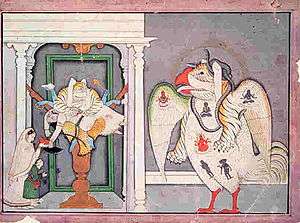
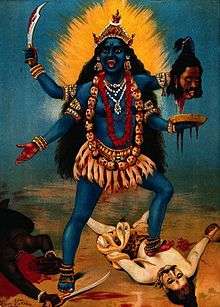
.jpg)
